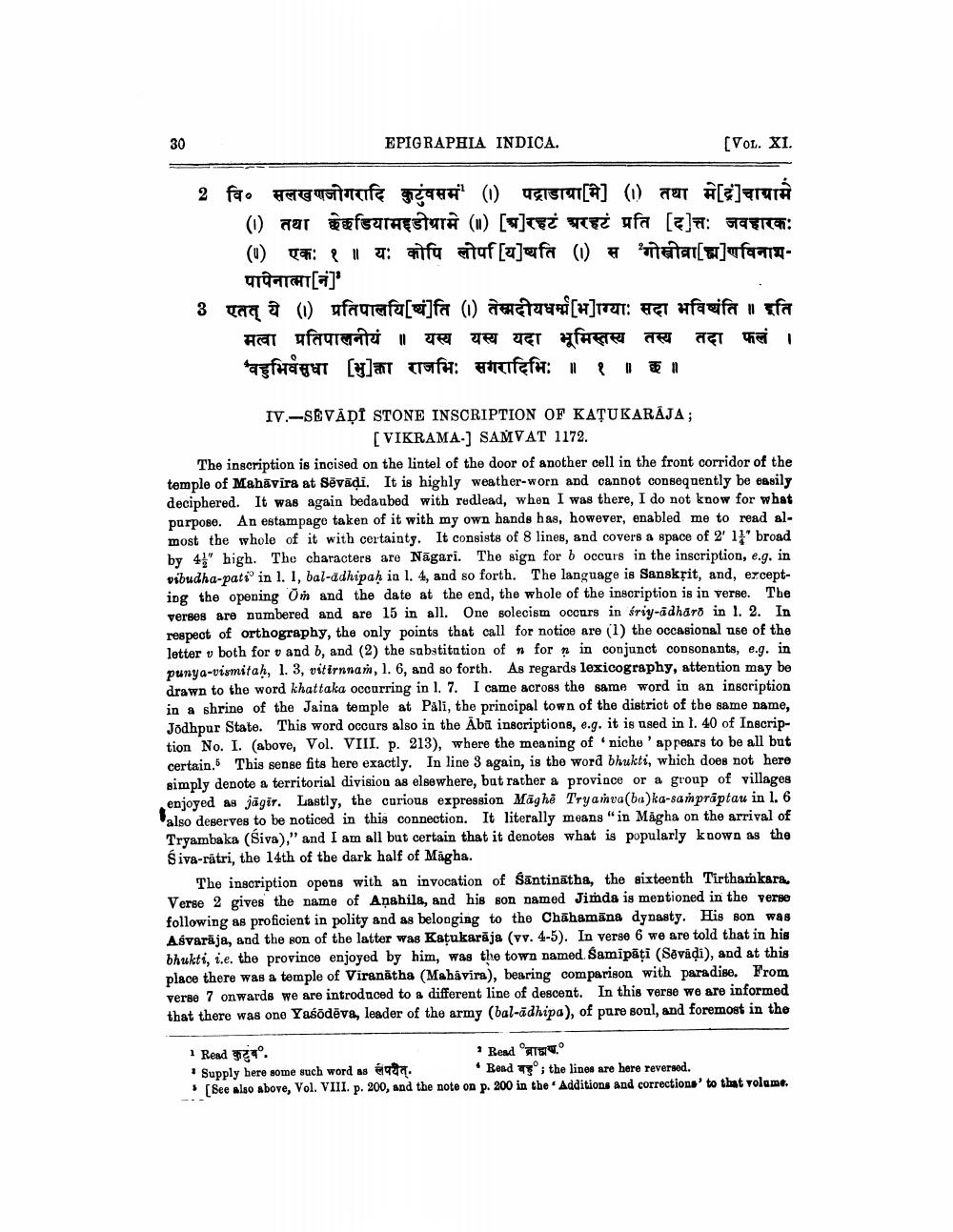________________
EPIGRAPHIA INDICA.
(VOL. XI.
2 fato Haititufe gati (1) Giera[a] (1) []arará
(1) par fout ESTATĀ (n) []TEŻ TEŻ afa [z]a: Erce: (1) Tal : afy sof[u]ofa (1) #Tea ] 1918
UTWGHT[=] 3 DAC (1) fagrafu[w]fa (1) TEET []orut: HET Hfavifa il fa
मत्वा प्रतिपालनीयं ॥ यस्य यस्य यदा भूमिस्तस्य तस्य तदा फलं । agfiragut [ulat trafat: arcfefa: P a n
IV.-SEVĀDI STONE INSCRIPTION OF KATUKARAJA;
[VIKRAMA.) SAVAT 1172. The inscription is incised on the lintel of the door of another cell in the front corridor of the temple of Mahāvira at Sēvādi. It is highly weather-worn and cannot consequently be easily deciphered. It was again beda ubed with redlead, when I was there, I do not know for what purpose. An estampage taken of it with my own hands has, however, enabled me to read almost the whole of it with certainty. It consists of 8 lines, and covers a space of 2 11 broad by 45" high. The characters are Nāgari. The sign for b occurs in the inscription, e.g. in vibudha-pats in l. 1, bal-adhipa) in l. 4, and so forth. The language is Sanskřit, and, excepting the opening Om and the date at the end, the whole of the inscription is in verse. The verses are numbered and are 15 in all. One solecism occurs in Sriy-adhard in 1. 2. In respect of orthography, the only points that call for notice are (1) the occasional use of the letter v both for o and b, and (2) the substitution of forn in conjunct consonants, e.g. in punya-vismstah, 1.3, vitirnnam, 1. 6, and so forth. As regards lexicography, attention may be drawn to the word khattaka occurring in l. 7. I came across the same word in an inscription in a shrine of the Jaina temple at Pali, the principal town of the district of the same name, Jodhpur State. This word occurs also in the Abū inscriptions, e.g. it is need in l. 40 of Inscription No. I. (above, Vol. VIII. p. 213), where the meaning of 'niche ' appears to be all but certain. This sense fits here exactly. In line 3 again, is the word bhukti, which does not here simply denote a territorial division as elsewhere, but rather a province or a group of villages enjoyed as jāgir. Lastly, the curious expression Māghe Tryamva(ba)ka-sampraptau in l. 6 Walso deserves to be noticed in this connection. It literally means "in Mägha on the arrival of Tryambaka (Siva)," and I am all but certain that it denotes what is popularly known as the Siva-rätri, the 14th of the dark half of Magha.
The inscription opens with an invocation of Santinatha, the sixteenth Tirthamkara Verse 2 gives the name of Anahila, and his son named Jimda is mentioned in the verse following as proficient in polity and as belonging to the Chāhamāna dynasty. His son was Asvarāja, and the son of the latter was Katukarāja (vv. 4-5). In verse 6 we are told that in his bhukti, i.e. the province enjoyed by him, was the town named. Samipați (Soviļi), and at this place there was a temple of Viranātha (Mahavira), bearing comparison with paradise. From verbe 7 onwards we are introduced to a different line of descent. In this verse we are informed that there was one Yaśödēva, leader of the army (bal-ādhipa), of pure soul, and foremost in the
Read go.
* Read A * Supply here some such word as 60%. * Read 78°; the lines are here reversed.
[See also above, Vol. VIII. p. 200, and the note on p. 200 in the Additions and corrections' to that volume.




